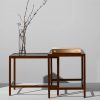The driving rhythms of deep powerful bass in rock and pop music as well as the timpani, bass drum and double basses of an orchestra complete the bottom few octaves of humans’ hearing range. Without it, music sounds shallow and anemic, so it’s no surprise that bass is a requirement of even the most basic hi-fi or home theater system.
Judging by the questions that arrive in my email about bookshelf vs floorstanding speakers and subwoofers, it’s time to cover a few bass basics that even old hands may have overlooked.
- Other things being equal (and there are many trade-offs that a designer may consider), the larger the physical cabinet of a speaker or subwoofer, the greater the potential for more bass and deeper bass. (That’s why very small speakers need subwoofer assistance to reproduce convincing powerful bass.)
- It’s possible to get deep bass from a smaller subwoofer enclosure, but something has to give, so the designer usually trades off efficiency and maximum loudness capability. The smaller sub with its typically smaller driver has to “work” harder to excavate 20-Hz low frequencies, so it will need a big amplifier. And because the smaller driver moves in and out over a greater excursion to generate the pressure waves, it won’t play as loud as a sub that uses a bigger enclosure and larger-diameter driver. For example, Axiom’s EP400 sub uses a quite compact cabinet with a smaller 8-inch dual-voice-coil driver. It can still produce ultra-low frequencies to 20 Hz and deeper, but it needs a big 500-watt amplifier to do it and it won’t play as loud in big rooms as its bigger EP500 brother, with its 12-inch diameter driver and larger cabinet.
- Corner locations of subwoofers and floorstanding speakers will produce powerful bass, but often it isn’t the smoothest bass–with one or two notes standing out or sounding bloated, like the old days of pounding disco “one-note” bass. A better location is part way along a side or rear wall. As you move a subwoofer away from a corner, deep bass becomes more even with less of a tendency to get “boomy”.
- If you’re using only a single subwoofer, don’t put your couch in the center of a room, because often that is where there’s a “null” or cancellation of bass. Sitting about 60% to 80% back from the front wall is about right. Avoid placing the couch against a rear wall. Typically that produces unnatural bass emphasis, a sort of hot spot like a corner location.
- If you don’t like the quality or quantity of bass you are getting, then move the subwoofer to a different location. Swap places with the subwoofer and your listening area, putting the sub where you normally sit. Crawl around the room while playing music with deep bass and the spot where the bass is smoothest and best is where you should move the subwoofer.otherwise…
- Get multiple subwoofers. The goal is to get deep, smooth and even bass at all listening locations and there is no better means to that end than adding a second subwoofer. Placing a second sub at opposite ends or opposite sides of the room will result in much smoother and better bass for all viewers and listening locations. In fact, the ultimate subwoofer setup (for those untouched by the recession) is four subwoofers. According to an associate of Dr. Floyd Toole, among the world’s foremost acoustical authorities, and one of Axiom designer Ian’ Colquhoun’s early mentors, two subwoofers will “get you close to 90% there” in terms of ideal four-subwoofer performance.






























